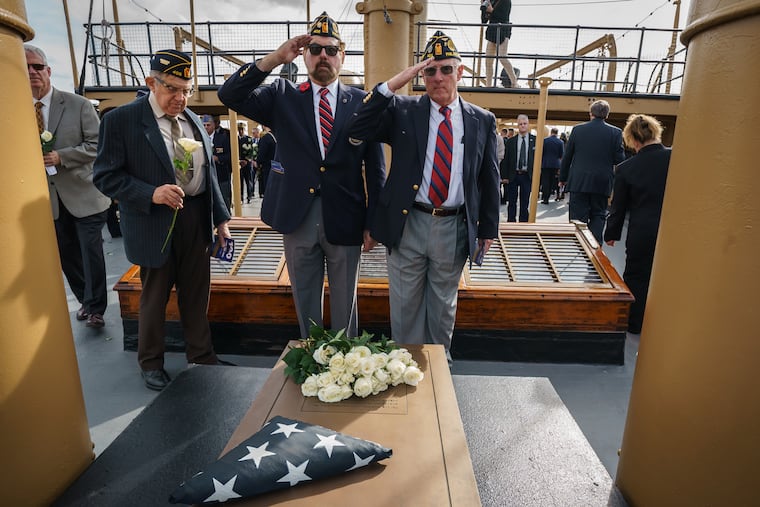Before the USS Olympia arrived in Philly, it brought the Unknown Soldier to Arlington
Tropical cyclones nearly sank the cruiser carrying the casket meant to honor massive numbers of anonymous war victims.

In the legendary naval battle that would help define the United States as a world power, not a single sailor aboard the flagship USS Olympia was reported killed, but a battle with nature nearly doomed the cruiser, 450 crew members, and the remains of one famously unidentified war casualty.
Despite an encounter with the parting shots of an otherwise quiet hurricane season, the Olympia, now a floating museum moored at Penn’s Landing, ultimately did complete its trans-Atlantic mission in time. It delivered the casket that on this day 100 years ago was enshrined in a white marble sarcophagus — the Tomb of the Unknown Soldier — at Arlington National Cemetery.
» READ MORE: A young veterans’ organization is taking on challenges in neighborhoods across Philadelphia
The entombment was the culmination of a massive funeral — attended by President Warren G. Harding and his predecessor, Woodrow Wilson — that coincided with the second anniversary of the treaty that ended “the war to end war” and that historians would blame for World War II.
It was a ceremony that spoke to one of the collateral horrors of war, inflicted on families and those who cared about those lost in one of the deadliest conflicts in human history.
About the Tomb
Historically, identifying the bodies of war dead was problematical, and was all the more challenging in World War I because of the sheer immensity of the casualties.
Astonishing numbers of the estimated 12.7 million killed have never been identified. The United States entered the war late, and its death toll was far less than that of some of the 15 other nations involved in the fighting. Still, the ranks of its unknown exceeded 40,000 and might have been more than 60,000, based on available figures.
Only 40% of the American bodies ever were identified, according to Amber Vincent, a public affairs specialist with the national cemetery.
» READ MORE: For veterans, a sense of community can make all the difference | Opinion
Identifying “dog tags” had not yet become official parts of U.S. uniforms, and Vincent said that the technology was unavailable to identify the remains of bodies that literally were “blown to bits.”
In 1920, Rep. Hamilton Fish Jr. (R., N.Y.), a World War I veteran, proposed interring one unidentified soldier in a special tomb at Arlington to symbolize all the unknown dead.
At a ceremony in what is now Châlons-en-Champagne, France, a body was chosen from among four exhumed from military cemeteries, and the casket placed aboard the Olympia for transport to the United States on Oct. 25.
‘You may fire when ready, Gridley’
In its heyday, the Olympia was a national superstar, said John Brady, a maritime historian and former head of the Independence Seaport Museum, which maintains and operates the Olympia as a tourist attraction.
“This ship is the beginning of the modern Navy,” he said. Its claim to fame was its role in the 1898 Battle of Manila Bay during the Spanish-American War.
Around daybreak on May 1, 1898, after catching sight of the Spanish fleet, Commodore George Dewey famously said to his captain, “You may fire when ready, Gridley.” The Spanish fleet was defeated in two hours.
The war was over three months later, the Spanish ceded the Philippines to the United States, signaling the end of one of the world’s most extensive empires and the expansion of another. The Olympia became a centerpiece of exuberant victory celebrations.
Its lingering fame made it a likely candidate to transport the remains of the Unknown Soldier, and Brady said it also was viewed as an affordable option, compared with other larger ships contending for the honor.
The casket was fastened to the deck because it was too large to fit below, and a Marine honor guard was assigned to protect it.
About the weather
Storm No. 5 of the 1921 Atlantic hurricane season developed on Oct. 15, and a far more potent one, No. 6, which became a major hurricane, popped up on Oct. 20 off the coast of Panama. The storms and their remnants evidently fomented dangerous storm waves in the Atlantic.
» READ MORE: On 9/11 anniversary, veterans and refugees seek healing through nature, art, and heart-to-heart
No. 6 was especially troublesome, arcing northward and following what the government’s Monthly Weather Review called an “abnormal” west-to-east path well into the Atlantic.
Strong high pressure, or heavier air, suppressed the storm to the south, said Jim Eberwine, former marine meteorologist with the National Weather Service, and that may have been a fateful development for the Olympia, which endured days of high seas.
Based on the ship’s log, the worst of it occurred on Halloween, with tropical storm winds and seas up to 15 feet. Through it all the Marine guards remained on duty.
“We lashed the fellow down with everything that we could tie on him,” the honor guard commander, Graves B. Erskine, would say 50 years later. “There were times we thought we might not make it home. The chaplain and the captain got together and he had a special service, praying to God that the ship wouldn’t sink.”
The Olympia today
A year later, the Olympia was decommissioned in Philadelphia. Through efforts of the Olympia Cruiser Association and preservation advocates, the ship was rescued and ultimately pursued its career as a floating museum with exhibits lining its lushly paneled walls.
The casket it transported remains entombed at its famous Arlington landmark and is guarded every minute by specially trained sentinels, come blizzards, thunderstorms, cold waves, or derechos — a tradition that had its stormy beginnings with the sentinels aboard the USS Olympia.
The annual Veterans Day ceremony aboard the Olympia will be held at 10 a.m. Thursday. The public is invited; masks are required.